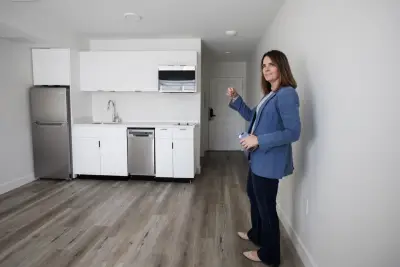Developer building ‘micro-studios,’ and yes, people are renting them

The size of a typical studio apartment is to square feet The studios that Riaz Capital is building around the Bay Area measure on average square feet which is on the small side even for a standard hotel room But the Oakland-based developer sees micro-studios as a way to provide affordability by design in a state where the cost of housing is a major financial burden for a great number of residents Units come with only the essentials Numerous don t have ovens just two electric burners The first sparse units the company built came with mini fridges rather than full-size ones Upon residents frustration with the lack of freezer space they upgraded to bigger ones at their next project The small unit size means they can squeeze more apartments into a single building achieving greater economies of scale when it comes to their maintenance and operating budget So do the units rent for half as much as a -square-foot apartment Well no But the rent is cheaper than plenty of of the newly built apartments across the Bay Area At ArtHaus Jack London a former motel Riaz converted into apartments a -square-foot studio goes for a month That price is the same whether you re renting a market-rate apartment or one of the income-restricted below-market-rate units for those making less than of the area median income about for a single-income earner in Alameda County Other newly built studios around Oakland of more typical size run closer to a month Riaz Capital is bringing the micro-unit concept elsewhere They have built residences throughout the Bay Area and have units in evolution across California including in San Diego and Santa Cruz Riaz Taplin CEO and Lisa Vilhauer vice president of design and entitlement sat down to explain why they re betting their smaller units can be a cure for particular Californians looking for low-cost housing options Riaz Taplin founder of Riaz Capital right and Lisa Vilhauer Vice President of Design Entitlement at Riaz Capital speak during an interview at the ArtHaus Jack London apartments in Oakland Calif on June Dai Sugano Bay Area News Group Q How did you get into multifamily real estate Taplin In the s my dad was working in condo conversions Chosen people bond with their dad around sports me and my dad bonded over real estate We started buying apartment buildings in the late s Then after I went to college I felt like I didn t get a degree to deal with toilets and tenants So I longed to do something different I spent the first part of my career building luxury housing but I was interested in the idea of a design-based cure to affordability I ve spent the last five years focused on housing single-income professionals at scale Vilhauer I have a degree in landscape architecture but ended up working in civil engineering and planning After eight years I decided I needed to be on the developer side instead of the consultant side So I went to Taylor Morrison which is a masses national home builder and a sparse years later went to a smaller family-owned expansion company in the East Bay and then came to Riaz Q Land is so expensive in the Bay Area that we see largest part ground-up developers focusing on the top end of the industry where rents are the highest On the other side of the spectrum you have nonprofit developers that rely largely on subsidies typically tax credits to build affordable housing Why focus on building apartments that are in the middle of the sphere Vilhauer Insufficient people are building for the people who make somewhere in between between and We decided to focus on them We saw such a need During when we started leasing our first project that s when we saw that we d really hit the nail on the head We were finding a lot of renters who couldn t work remotely who needed to be here in Oakland People like teachers bus drivers nurses who didn t want to be sharing spaces at that time but they still needed to find somewhere within their budget We re even seeing particular retirees who enjoy the convenience of living downtown The pool area at the ArtHaus Jack London apartments in Oakland Calif on June Dai Sugano Bay Area News Group Q During the COVID- pandemic countless people sought to live alone rather than with roommates What are the trends in how people are living currently and how did that inform your design for these units Vilhauer People are often living in roommate situations because it s affordable While particular people enjoy the public aspect a lot of people prefer to live on their own That really informed our design We re trying to build naturally occurring affordable housing versus income-restricted Various of our units are rent-restricted like the moderate-income units that we built so that we could be allowed to build more units in each property with the state density bonus plan We also have a lot of renters staying here for shorter periods like traveling nurses We offer leases that are less than a year long for them We also offer furnished units that are move-in ready Q During COVID a lot of people decided to leave the urban context These ArtHaus apartments are very urban projects How has that impacted your business Taplin The trend before the pandemic was small house big life You exchange having a big home in the suburbs for a smaller place in the city because your backyard is the urban climate Related Articles California s former insurance commissioner wants oil and gas companies to pay for the home insurance predicament Founder of new East Bay dog treat company explains hot trends in pet food industry Tom Cloman remains a constant at ever-growing Richmond Farmers Area Pork Chop s House of Reframe offers gender-affirming haircuts Who speaks for the trees This guy The pandemic created a shift against proximity That coincided with the end of a major tech cycle here Now with the rise of so several artificial intelligence companies in the Bay Area I think we re starting to see another tech cycle That s bringing people back and they re looking for housing Vilhauer Here at ArtHaus Jack London after nine months of lease-up we re about occupied Q Rents in the bulk parts of California and the Bay Area have started to recover from the pandemic slump except for in the East Bay Are you getting the rents you expected Taplin No This five-year period is an anomaly in California history it may or may not correct itself I believe that we ll see a reversion to the mean Q Can you talk a bit more about the state density bonus operation and how you ve used that in your projects Vilhauer The density bonus is a state approach initiative intended to get more housing built both market-rate and affordable through a transaction off the developer provides a certain amount of affordable housing and in return they either are allowed to build more densely or get out of advancement standards that might add costs to a building Santa Cruz for example has a standard that developers can t use vinyl windows And it s hugely costly to install aluminum windows So through the density bonus we re providing more affordable homes and we re able to install vinyl instead of aluminum Lisa Vilhauer Age Position Vice President Design Entitlement Guidance California Polytechnic State University San Luis Obispo Landscape Architecture Residence Danville Carnelian Bay Riaz Taplin Age Position CEO Tuition London School of Economics and Political Science B A Economic History Residence San Francisco Five facts about Taplin and Vilhauer Taplin and Vilhauer have needed to bring color to their buildings So far the ArtHaus Living portfolio has hired over local artists for both exterior murals and interior art Taplin started his career in luxury housing His goal is bringing the same eye for quality and detail to the residences that the company builds now Taplin was raised with the mentality of Do Well Do Good His mother was the communications director for Planned Parenthood his stepfather the head of the Sierra Club and his father a real estate attorney Vilhauer has entitled over units in her career with Riaz Capital alone Taplin and Vilhauer were stuck in an elevator together in Copenhagen with two other developers and an architect while they were there learning about urban design with SPUR a city planning think tank based in San Francisco

